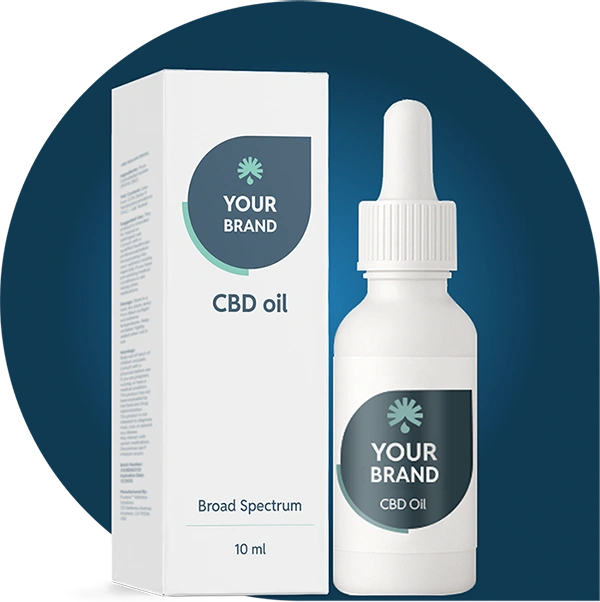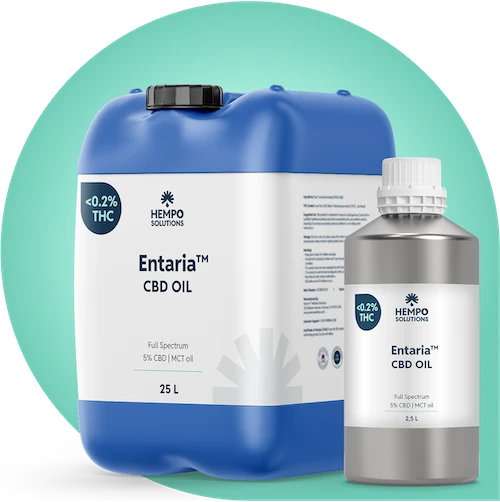Table of Contents
-
Cannabinoids Explained
How Cannabinoids Interact with the ECS
Types of Cannabinoids and Their Effects
Entourage Effect and Cannabinoid Synergy
Synthetic vs Natural Cannabinoids
Influence on Product Quality
Matching Cannabinoids to Customer Needs
Choosing the Right Cannabinoid Profiles
Final Takeaway
Cannabinoids Explained
Cannabinoids are the bioactive compounds found in cannabis that contribute to the plant’s therapeutic effects. Unlike terpenes, which influence aroma and flavour, cannabinoids interact directly with the body’s Endocannabinoid System (ECS) – a complex cell-signalling network that regulates functions like mood, pain, sleep, appetite, and immune response. In practical terms, cannabinoids directly influence how a product performs and whether it achieves its intended benefits.
There are three primary types of cannabinoids:
-
Phytocannabinoids – Found in hemp and cannabis plants, these are the most relevant for CBD retailers. Common examples include CBD, THC, CBG, CBN, and CBC – each offering unique effects such as relaxation, focus, or inflammation support.
-
Endocannabinoids – Produced naturally in the human body, compounds like anandamide (AEA) and 2-AG bind to CB1 and CB2 receptors to help regulate internal stability and overall wellbeing.
-
Synthetic cannabinoids – Lab-created molecules such as dronabinol or nabilone are used in pharmaceuticals under medical supervision. While not typically part of consumer wellness products, they’re important for understanding the broader cannabinoid landscape.
For retail brands and CBD product manufacturers, recognising that not all cannabinoids are the same, is very important. Each one interacts with the ECS in unique ways, meaning that formulations should be tailored to specific wellness goals such as sleep, stress, or recovery – rather than just following trends.
Understanding the types and functions of cannabinoids is a foundation for choosing most effective CBD products.
How Cannabinoids Interact with the ECS
To understand how cannabinoids affect the body, it’s important to first understand the system they interact with: the Endocannabinoid System (ECS). This biological network is present throughout the brain, immune system, skin, and digestive tract, and plays a major role in maintaining balance within the body. When cannabinoids like CBD, THC, or CBG enter the body, they interact with ECS receptors to influence functions such as pain, inflammation, sleep, mood, and more. For CBD brands, this isn’t abstract science – it’s the mechanism that determines whether a product supports relaxation, eases discomfort, or has little effect at all. Knowing how different cannabinoids modulate the ECS, can help brands offer CBD products that meet customer needs and deliver consistent results.
Types of Cannabinoids and Their Effects
Not all cannabinoids behave the same way. Each has its own effects, receptor targets, and therapeutic potential. For retailer brands, knowing these differences is crucial when selecting or formulating CBD products that provide clear, predictable benefits.
-
CBD (Cannabidiol) is non-psychoactive and widely recognised for its anti-inflammatory, anxiolytic, and neuroprotective properties. It modulates several receptor systems beyond CB1 and CB2, including 5-HT1A and TRPV1, which contributes to its broad functional appeal in wellness products.
-
THC (Δ9-Tetrahydrocannabinol) binds strongly to CB1 receptors in the brain and CB2 receptors in the body, producing psychoactive effects and potential pain relief. In addition, THC is believed to contribute to the entourage effect, enhancing the therapeutic properties of other cannabinoids. It may also promote relaxation and has shown promise in helping with conditions like Parkinson’s disease. Its use in CBD products is tightly regulated, typically limited to 0.2-0.3% depending on the market.
-
CBG (Cannabigerol), known as the “precursor cannabinoid,” plays a central biosynthetic role in the plant. On its own, it shows promise in supporting focus, reducing inflammation, and offering neuroprotection – making it ideal for functional wellness lines.
-
CBN (Cannabinol) emerges as THC oxidises and is often positioned as a sleep-supporting cannabinoid due to its mild sedative effects, though research is still in early stages.
-
CBC (Cannabichromene) shows anti-inflammatory and mood-supporting potential and may synergise with other cannabinoids to enhance overall effectiveness.
Understanding the benefits of each cannabinoid helps brands avoid “one-size-fits-all” formulations and instead select products that are tailored to specific needs like stress support, recovery, sleep, or focus.
Entourage Effect and Cannabinoid Synergy

Cannabinoids don’t work alone. Their therapeutic effects can be influenced by other compounds, particularly other cannabinoids and terpenes, in what’s known as the entourage effect. For example, combining CBD with small amounts of THC can produce different results than either compound on its own, particularly in treating anxiety or muscle spasticity. Terpenes like myrcene or limonene also shape effects such as relaxation or focus by modulating cannabinoid activity at the receptor level.
For retailers evaluating full-spectrum or broad-spectrum CBD products, understanding the entourage effect can explain why these formulations often deliver more effective results than isolates. This knowledge is valuable when educating customers about why certain blends may perform better, even at lower cannabinoid concentrations.
Synthetic vs Natural Cannabinoids
Cannabinoids fall into two categories: naturally occurring (from cannabis plants or the body) and synthetic (lab-made analogues). While some synthetic cannabinoids like dronabinol and nabilone are used safely in clinical settings, others, especially those found in unregulated vape or edible products, are associated with inconsistent effects and safety concerns.
For retailers, the issue is about risk. Many synthetic cannabinoids lack comprehensive safety data, legal clarity, and quality controls. This increases liability and could affect consumer safety and brand reputation. When sourcing white-label or bulk CBD products, ensure cannabinoids are hemp-derived, supported by third-party testing, and clearly labeled. If a supplier cannot confirm these standards, it’s better to look elsewhere.
How Cannabinoids Influence Product Quality
In the CBD industry, quality isn’t just about how clean or compliant a product is. It’s also about how well it works. The effectiveness of a product is determined largely by its cannabinoid content – what’s included, in what ratios, and whether the compounds are active or degraded. Therefor its important to talk about different types of CBD.
Retailers often focus on sourcing “full-spectrum” or “broad-spectrum” products, but not all formulations are equal. A full-spectrum oil high in CBD and CBG, with trace amounts of CBN and low THC, will perform differently from one dominated by CBD alone. Two products with the same label and lab certification can offer vastly different results due to differences in cannabinoid profiles.
The presence of acidic cannabinoids (like CBDA or THCA), cannabinoid degradation (like THC oxidising into CBN), or the interaction of cannabinoids with terpenes can completely change the customer experience. This influences both the therapeutic value and the perceived quality of the product, which in turn affects brand trust.
Matching Cannabinoids to Customer Needs
Customers rarely search for specific cannabinoids like CBG or CBN. Instead, they look for solutions to issues like stress, sleep, recovery, or pain relief. It’s up to retailers to translate these needs into product options – and cannabinoids are the key.
For example:
-
Stress and anxiety: Products rich in CBD and low amounts of THC (paired with terpenes like linalool) tend to provide calming effects without causing drowsiness.
-
Sleep support: Look for formulas containing CBN and low-dose of THC, which have sedative properties that make them effective for sleep.
-
Recovery for athletes: CBG and CBD work well together in recovery topicals and pre-workout tinctures due to their anti-inflammatory and neuroprotective properties.
-
Focus and mood support: Formulations with CBG and CBC are emerging in “clarity” or “daytime” products, offering mental balance without overstimulation.
Retail brands who understand how cannabinoids function can create more tailored product lines, helping customers find the perfect solution and boosting satisfaction, retention, and word-of-mouth.
Choosing the Right Cannabinoid Profiles
When evaluating CBD products to source for your business – whether white-label, private-label, or bulk – the cannabinoid profile should be the main selection criterion. Look beyond the total CBD content and focus on the presence and balance of other active cannabinoids, as these are what determine the product’s overall effectiveness.
-
Does the COA (Certificate of Analysis) show relevant levels of CBG, CBN, or CBC for the intended use?
-
Are acidic cannabinoids still present, indicating a raw formulation, or has everything been decarboxylated for active use?
-
Is the THC level compliant but still present enough to support the entourage effect?
Select products that align with your customers’ needs: sleep, stress relief, energy, focus, or recovery. Ensure each product contains the right mix of cannabinoids to deliver the desired effect.
Partner with informed manufacturers who can explain why specific cannabinoid ratios were chosen. If they can’t, it’s time to look for another supplier. Retailers who collaborate with knowledgeable producers will get better-performing products, fewer returns and more returning customers.
Product quality starts with chemistry. The more you understand cannabinoids, the better positioned you are to offer products that deliver real and effective results.
Final Takeaway
In the CBD industry, product performance isn’t random – it’s based on cannabinoid science. Understanding how each compound works, and how they interact with one another, provides retailers with a competitive edge. By selecting products that meet specific customer needs, you’ll deliver experiences that build trust and keep customers coming back. The more you know about cannabinoids, the better you’ll be able to build a product range that truly works.







